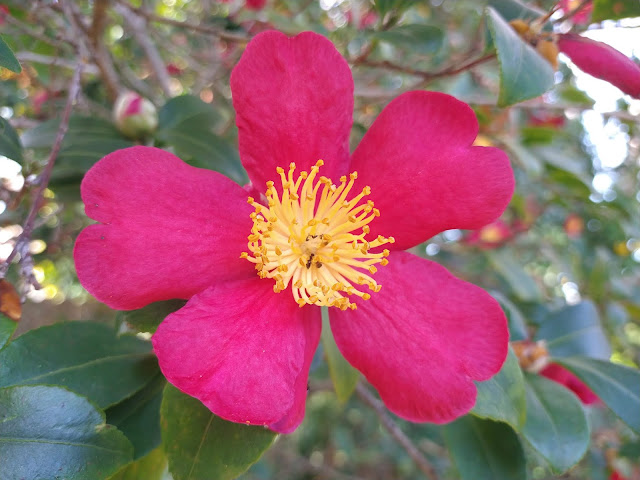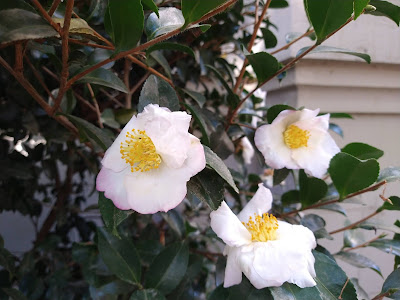
These fall-flowering, fragrant varieties started opening in September

|
|
Here's a cheery sight on a gray day: a Sasanqua camellia, in full bloom this week, and ever since early October. (Photos: Debbie Arrington)
|
This season, Christmas camellias arrived early. Fortunately, there still are plenty to brighten our Sacramento holiday season.
Thanks to (mostly dry and warm) weather conditions, Camellia sasanqua started blooming locally in September. Several white-flowered bushes lining the K Street side of the Cathedral of the Blessed Sacrament were in full bloom two weeks after Labor Day. By October, many heritage bushes in Capitol and McKinley parks starting blooming, too.
My own trio of Yuletide camellias started opening their flowers in early October and are still going strong. That’s more than eight weeks of flowers, and counting.
A close cousin to the February-blooming Japonica camellias, Sasanqua camellias usually blooms anytime from October to December. That’s also earned this species another nickname: Fall-blooming camellias.

|
|
This Sasanqua camellia was blooming in October along the K Street side
of Cathedral of the Blessed Sacrament downtown.
|
Another plus for Christmas camellias: They’re intensely fragrant. (You can’t say the same for most Japonicas.) Supporting beneficial wildlife, these fall and early winter blooms also provide food to bees and hummingbirds when fewer flowers are available.
With a reputation for hardiness, Christmas camellias can thrive in spots where Japonicas struggle. They can tolerate drought conditions and colder temperatures. Although they prefer filtered shade or dappled sunlight, Christmas camellias also can take more full sun than Japonica camellias.
Once cold rain begins to pelt the flowers, Christmas camellias start dropping their flowers in bunches. Pick up and dispose of those fallen flowers to help prevent petal blight, a fungal disease that turns camellia petals prematurely brown. Otherwise, those spores will hang around and infect the Japonica camellias getting ready to flower in February.
As landscape plants, Christmas camellias are long-lived (often several decades) and easy care. After flowering, they need little if any pruning; just remove dead wood and gently shape if necessary.
Then, feed Sasanqua bushes with an acid-type fertilizer formulated for camellias, which prefer slightly acid soils.
But don’t feed your Japonica camellias until after they finish blooming in March. Feeding while camellias are in bloom (or about to bloom) may cause them to drop unopened buds.
Thinking about a gift plant? Christmas camellias can be found in bloom now in local nurseries. These bushes can be transplanted after they finish bloom and will continue to bring smiles for many years to come.
For more about growing camellias locally: https://www.camelliasocietyofsacramento.org/
Comments
0 comments have been posted.Sacramento Digs Gardening to your inbox.
Food in My Back Yard Series
May 6: Maintain soil moisture with mulch for garden success
April 29: What's (already) wrong with my tomato plants?
April 22: Should you stock up on fertilizer? (Yes!)
April 15: Grow culinary herbs in containers
April 8: When to plant summer vegetables
April 1: Don't be fooled by these garden myths
March 25: Fertilizer tips: How to 'feed' your vegetables for healthy growth
March 18: Time to give vegetable seedlings some more space
March 11: Ways to win the fight against weeds
March 4: Potatoes from the garden
Feb. 25: Plant a fruit tree now -- for later
Feb. 18: How to squeeze more food into less space
Feb. 11: When to plant? Consider staggering your transplants
Feb. 4: Starting in seed starting
Sites We Like
Garden Checklist for week of May 11
Make the most of the lower temperatures early in the week. We’ll be back in the 80s by Thursday.
* Plant, plant, plant! It’s prime planting season in the Sacramento area. Time to set out those tomato transplants along with peppers and eggplants. Pinch off any flowers on new transplants to make them concentrate on establishing roots instead of setting premature fruit.
* Direct-seed melons, cucumbers, summer squash, corn, radishes, pumpkins and annual herbs such as basil.
* Harvest cabbage, lettuce, peas and green onions.
* In the flower garden, direct-seed sunflowers, cosmos, salvia, zinnias, marigolds, celosia and asters. (You also can transplant seedlings for many of the same flowers.)
* Plant dahlia tubers.
* Transplant petunias, marigolds and perennial flowers such as astilbe, columbine, coneflowers, coreopsis, dahlias, rudbeckia and verbena.
* Keep an eye out for slugs, snails, earwigs and aphids that want to dine on tender new growth.
* Feed summer bloomers with a balanced fertilizer.
* For continued bloom, cut off spent flowers on roses as well as other flowering plants.
* Add mulch to the garden to maintain moisture. Mulch also cuts down on weeds. But don’t let it mound around the stems or trunks of trees or shrubs. Leave about a 6-inch-to-1-foot circle to avoid crown rot or other problems.
* Remember to weed! Pull those nasties before they set seed.
* Water early in the day and keep seedlings evenly moist.